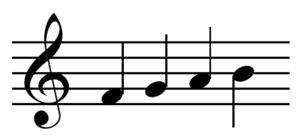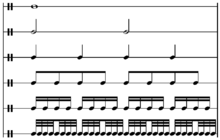Quarter note
| Look up quarter note in Wiktionary, the free dictionary. |
A quarter note (American) or crotchet (British, from the sense 'hook') is a note played for one quarter of the duration of a whole note (or semibreve). Often, musicians will say that a crotchet is one beat, but this is not always correct, as the beat is indicated by the time signature of the music; a quarter note may or may not be the beat. Quarter notes are notated with a filled-in oval note head and a straight, flagless stem. The stem usually points upwards if it is below the middle line of the stave or downwards if it is on or above the middle line. However, the stem direction may differentiate more than one part. The head of the note also reverses its orientation in relation to the stem. (See image.)
Overview
In Unicode, the symbol is U+2669 (♩).



A related value is the quarter rest (or crotchet rest). It denotes a silence of the same duration as a quarter note. It typically appears as the symbol ![]() , plus, occasionally, as the older symbol
, plus, occasionally, as the older symbol ![]() .[1][2]
.[1][2]
The note derives from the semiminima of mensural notation. The word crotchet comes from Old French crochet, meaning 'little hook', diminutive of croc, 'hook', because of the hook used on the note in black notation. However, because the hook appeared on the eighth note (or quaver) in the later white notation, the modern French term croche refers to an eighth note.
The quarter note is played for half the length of a half note and twice that of an eighth note. It is one beat in a bar of 4/4. The term quarter note is a calque (loan translation) of the German term Viertelnote. The names of this note (and rest) in many other languages are calqued from the same source; Romance languages usually use a term derived from the Latin negra meaning ‘black’:
| Language | note name | rest name |
|---|---|---|
| Arabic | السوداء | سكتة السوداء |
| Bulgarian | четвъртинка | четвъртинка пауза |
| Catalan | negra | silenci de negra |
| Chinese | 四分音符 (pinyin: sìfēn yīnfú) | 四分休止符 (pinyin: sìfēn xiūzhǐfú) |
| Croatian | četvrtinka | četvrtinska pauza |
| Czech | čtvrťová nota | čtvrťová pauza |
| Danish | fjerdedelsnode | fjerdedelspause |
| Dutch | kwartnoot | kwartrust |
| Finnish | neljäsosanuotti | neljäsosatauko |
| French | noire | soupir |
| Galician | negra | silencio de negra |
| German | Viertelnote | Viertelpause |
| Greek | tetarto (τέταρτο) | pausi tetartou (παύση τετάρτου) |
| Italian | semiminima, nera, croma[3] | pausa di semiminima |
| Japanese | 4分音符 | 4分休符 |
| Korean | 4분음표(四分音標 sabun eumpyo) | 4분쉼표(四分-標 sabun swimpyo) |
| Norwegian | fjerdedelsnote | fjerdedelspause |
| Persian | سیاه | سکوت سیاه |
| Polish | ćwierćnuta | pauza ćwierćnutowa |
| Portuguese | semínima | pausa de semínima |
| Russian | четвертная нота | четвертная пауза |
| Serbian | četvrtin(k)a / четвртин(к)а | četvrtinska pauza/ четвртинска пауза |
| Slovak | štvrťová nota | štvrťová pomlčka |
| Spanish | negra | silencio de negra |
| Swedish | fjärdedelsnot | fjärdedelspaus |
| Turkish | dörtlük nota | dörtlük es |
| Thai | โน๊ตตัวดำ | ตัวหยุดตัวดำ |
The Galician, Catalan, French, and Spanish names for the note (all of them meaning "black") derive from the fact that the semiminima was the longest note to be colored in mensural white notation, which is true as well of the modern form.
The Bulgarian, Chinese, Croatian, Czech, Japanese, Korean, Polish, Russian, Serbian and Slovak names mean "quarter" (for the note) and "quarter's pause" (for the rest).
Notes
- ↑ Examples of the older symbol are found in English music up to the late 20th century, e.g. W. A. Mozart Requiem Mass, vocal score ed. W. T. Best, pub. London: Novello & Co. Ltd. 1879
- ↑ Rudiments and Theory of Music Associated Board of the Royal Schools of Music, London 1958. I,33 and III,25. The former shows both forms without distinction, the latter the "old" form only. The book was the standard theory manual in the UK up until at least 1975. The "old" form was taught as a manuscript variant of the printed form.
- ↑ John Morehen & Richard Rastall. "Crotchet". In L. Root, Deane. Grove Music Online. Oxford Music Online. Oxford University Press. (subscription required)